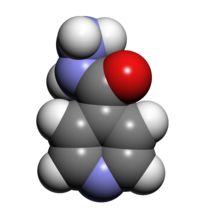 | |
 | |
| Clinical data | |
|---|---|
| Trade names | Hydra, Hyzyd, Isovit, others |
| Other names | isonicotinic acid hydrazide, isonicotinyl hydrazine, INH, INAH, INHA |
| AHFS/Drugs.com | Monograph |
| MedlinePlus | a682401 |
| License data | |
| Pregnancy category |
|
| Routes of administration | By mouth, intramuscular, intravenous |
| ATC code | |
| Legal status | |
| Legal status | |
| Pharmacokinetic data | |
| Protein binding | Very low (0–10%) |
| Metabolism | liver; CYP450: 2C19, 3A4 inhibitor |
| Elimination half-life | 0.5–1.6h (fast acetylators), 2-5h (slow acetylators) |
| Excretion | urine (primarily), feces |
| Identifiers | |
| |
| CAS Number | |
| PubChem CID | |
| DrugBank | |
| ChemSpider | |
| UNII | |
| KEGG | |
| ChEBI | |
| ChEMBL | |
| NIAID ChemDB | |
| CompTox Dashboard (EPA) | |
| ECHA InfoCard | 100.000.195 |
| Chemical and physical data | |
| Formula | C6H7N3O |
| Molar mass | 137.142 g·mol−1 |
| 3D model (JSmol) | |
| |
| |
| (verify) | |
Isoniazid, also known as isonicotinic acid hydrazide (INH), is an antibiotic used for the treatment of tuberculosis.[4] For active tuberculosis, it is often used together with rifampicin, pyrazinamide, and either streptomycin or ethambutol.[5] For latent tuberculosis, it is often used alone.[4] It may also be used for atypical types of mycobacteria, such as M. avium, M. kansasii, and M. xenopi.[4] It is usually taken by mouth, but may be used by injection into muscle.[4]
- ^ "Isoniazid (Nydrazid) Use During Pregnancy". Drugs.com. 7 October 2019. Retrieved 24 January 2020.
- ^ "FDA-sourced list of all drugs with black box warnings (Use Download Full Results and View Query links.)". nctr-crs.fda.gov. FDA. Retrieved 22 Oct 2023.
- ^ "Drug and medical device highlights 2018: Helping you maintain and improve your health". Health Canada. 14 October 2020. Retrieved 17 April 2024.
- ^ a b c d "Isoniazid". The American Society of Health-System Pharmacists. Archived from the original on 20 December 2016. Retrieved 8 December 2016.
- ^ World Health Organization (2009). Stuart MC, Kouimtzi M, Hill SR (eds.). WHO Model Formulary 2008. World Health Organization. p. 136. hdl:10665/44053. ISBN 9789241547659.